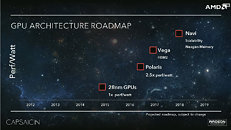Wednesday, May 11th 2016

AMD Pulls Radeon "Vega" Launch to October
In the wake of NVIDIA's GeForce GTX 1080 and GTX 1070 graphics cards, which if live up to their launch marketing, could render AMD's high-end lineup woefully outperformed, AMD reportedly decided to pull the launch of its next big silicon, Vega10, from its scheduled early-2017 launch, to October 2016. Vega10 is a successor to "Grenada," and will be built on the 5th generation Graphics CoreNext architecture (codenamed "Vega").
Vega10 will be a multi-chip module, and feature HBM2 memory. The 14 nm architecture will feature higher performance/Watt than even the upcoming "Polaris" architecture. "Vega10" isn't a successor to "Fiji," though. That honor is reserved for "Vega11." It is speculated that Vega10 will feature 4096 stream processors, and will power graphics cards that compete with the GTX 1080 and GTX 1070. Vega11, on the other hand, is expected to feature 6144 stream processors, and could take on the bigger GP100-based SKUs. Both Vega10 and Vega11 will feature 4096-bit HBM2 memory interfaces, but could differ in standard memory sizes (think 8 GB vs. 16 GB).
Source:
3DCenter.org
Vega10 will be a multi-chip module, and feature HBM2 memory. The 14 nm architecture will feature higher performance/Watt than even the upcoming "Polaris" architecture. "Vega10" isn't a successor to "Fiji," though. That honor is reserved for "Vega11." It is speculated that Vega10 will feature 4096 stream processors, and will power graphics cards that compete with the GTX 1080 and GTX 1070. Vega11, on the other hand, is expected to feature 6144 stream processors, and could take on the bigger GP100-based SKUs. Both Vega10 and Vega11 will feature 4096-bit HBM2 memory interfaces, but could differ in standard memory sizes (think 8 GB vs. 16 GB).

116 Comments on AMD Pulls Radeon "Vega" Launch to October
www.3dcenter.org/news/amd-zieht-den-vega-launch-angeblich-auf-oktober-2016-vor
I mean, dafuq were they thinking at AMD, why was it ok not to get something that takes on 980Ti? (490/490x)
Maybe they focused on "semi-custom" (consoles) and mobile chips for Apple too much.
For one founders edition is basically NVidia brand and reference cooler. From all that I have heard and read manufacturers will launch their cards along side NVidia's own at suggested retail price with the reference cooler.
There's no reason to think the cards will be sold at higher than suggested retail unless there's low stock. Also, why October? Because AMD will release Vega then? That why you think prices will come down in Oct?
4 years ago I bought my 670 at the EXACT same price it launched for.
Maybe the were expecting from Nvidia to focus on low power too.
Or they didnt expect TSMCs 16nm to clock that high.
All's good in frog town.
Was it planned as a surprise for nVidia.
Or is it a response to bad surprise (although I don't fucking get how that could have been surprising) from nVidia. (bad for AMD that is)
I mean, HBM2 in... Oct 2016? Wow.
Just an example obviously but the main point is....people forget.
Vega is replacement for Fiji
the writing is on the wall, there is a reason vega has hbm2
As of now, NOBODY had neither 1070, 1080 or any Polaris for an independent test, Nvidia silicon wasn't shown last week (somebody smart will quickly claim opposite, yes CEO was *holding* one), we had selective benchmarks by manufacturer claiming *something* - and final 'proof' was some guy supposedly running unreleased game on youtube at, supposedly, insane speed.
Meanwhile, in the opposite corner, several months ago we saw unnamed card beating another 'comparative' one (at least it was manufacturer silicon) in... power-usage. And now the release date of another future product suddenly become CLOSER for 6 months, despite the opposite being true in most cases.
But thanks to these informative posts, now I know so much more! Who-was-punched-and-where and what other cards beat TitanX and so on...
Personally, I consider card released when I am able to buy it in local store. At that time, there are usually whole bunch of benchmarks proving this-and-that, and prices are often adjusted from initial recommendations. If I'm buying something (usually mid-range), I decide *then*. But that's just me...
We'll see in time if there is some more solid info backing this.
A.) a 256 bit bus is much easier to wire up physically on a PCB than a 384 bit bus, to say nothing of a 512 bit bus. This reduces the number of faulty PCBs during manufacturing and decreased PCB complexity, increasing yields.
B.) a 256 bit bus does not require as many memory controllers (4 64 bit buses compared to 6 for 384 bit or 8 for 512 bit) which cuts down on not just power use, but chip complexity as well. Again, cheaper and easier to make with better yields than a 384 bit chip. This was also part of the reason hawaii was such a power hog, a 512 bit bus is hard to make power efficient.
C.) a 256 bit bus can outdo a 384 bit bus, depending on the memory tech behind it. We dont know how much bandwidth GDDR5X pushes on the 1080. It could very well push more data than a 384 bit GDDR5 bus. GDDR5X clocks much higher, and the final bandwidth number is what matters, not the number of bits. GDDR5X also has larger memory chips available than ddr5 does IIRC, making it cheaper to offer 8GB VRAM capacities. Fewer memory chips also means lower power draw.